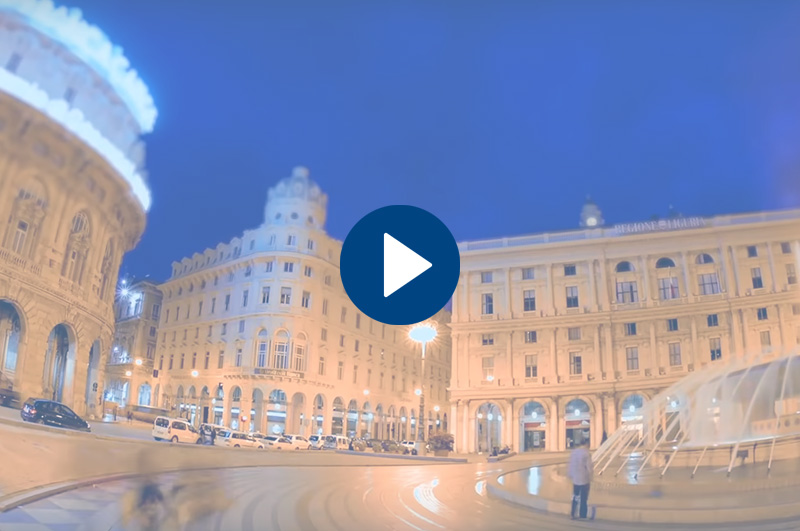10-days PERUGINO PRIVATE TOUR
Tuscia, Umbria & Marche
From the medieval city of Viterbo to Assisi, then Le Marche region with its quant cities, Urbino and Ascoli, and finally back to shady Umbria and its wonderful villages and small towns. A journey away from crowds, enjoying the hospitality of local people and unknown gourmet specialities in the very heart of Italy!
HIGHLIGHTS
- Viterbo, the city of the Popes
- Orvieto and Civita, the cities “on the rocks”
- Perugia, the perfect mix of tradition and modernity
- Assisi, the extraordinary land of Francis
- Urbino, the Duke’s retreat from the fatigues of the war
- San Marino, a 1,000-year story of independence
- Genga, the temple in the cave
- Ascoli Piceno, the city of a hundred towers and bien vivre
- Spoleto, urban harmony across the centuries
- Tivoli, an invitation from the Emperor
WHAT'S INCLUDED:
Accommodations in Double Room with Continental Breakfast (*):
- Days 1 & 2: 3* to 5* Hotel in Viterbo city centre
- Day 3: 3* to 5* Hotel in Orvieto city centre
- Day 4: 3* to 5* Hotel in Assisi city centre
- Days 5 & 6: 3* to 5* Hotel in Urbino city centre
- Days 7 & 8: 3* to 5* Hotel in Ascoli Piceno
- Days 9 & 10: 3* to 5* Hotel in Todi area
- Day 11: 3* to 5* Hotel in Rome city centre
(*) The Hotel list is available upon request
Transfers(**):
- Day 1: Transfer to Viterbo – Stopover in Caprarola
- Day 3: Transfer to Orvieto – Stopover along the way
- Day 4: Transfer to Assisi – Stopover in Perugia
- Day 5: Transfer to Urbino – Stopover in Acqualagna
- Day 9: Transfer to your accommodation in Todi area - Stopover in Spoleto
- Day 10: Transfer by private car to your accommodation in Rome city centre – Stopover in Tivoli
(**) All transfer by private car (2 pax) / minivan (3 to 6 pax) / minibus (7 to 10 pax)
Guided Visits / Tours (***) / Activities:
- Day 1: Visit of Cardinal Farnese Renaissance Villa in Caprarola - 2-hour private walking tour of Viterbo city centre with an Authorised Tourist Guide
- Day 2: 2-hour cheese-making class with lunch in Viterbo area – Half-day excursion to Civita di Bagnoregio
- Day 3: Visit of an Orvieto wine cellar with tastings - 2-hour private walking tour of Orvieto city centre with an Authorised Tourist Guide
- Day 4: 2-hour private walking tour of Assisi city centre with an Authorised Tourist Guide
- Day 5: 2-hour truffle hunt in Acqualagna area
- Day 6: 2.5-hour private walking tour of Urbino city centre with an Authorised Tourist Guide – Half-day excursion to San Marino
- Day 7: Full-day excursion to Genga & Fabriano - Free visit of Valadier’s “Tempietto” in Genga - Admission and guided tour of the Museum of Paper in Fabriano - Drop off at your accommodation in Ascoli Piceno
- Day 8: 2.5-hour private walking tour of Ascoli city centre with an Authorised Tourist Guide - 2-hour Cooking Class in Ascoli area
- Day 9: Visit of an olive oil mill in Todi area with tastings
- Day 10: Full-day excursion to Deruta and Montefalco - Visit of a ceramics laboratory in Deruta - Visit of a Sagrantino di Montefalco winery with tastings
- Full-day private walking tour of the Hadrian’s Villa and Villa d’Este with an Authorised Tourist Guide
(***) All tours by private car (2 pax) / minivan (3 to 6 pax) / minibus (7 to 10 pax)
Admission tickets:
- Cardinal Farnese Renaissance Villa in Caprarola
- Galleria Nazionale della Marche in Urbino
- Museum of Paper in Fabriano
- Hadrian’s Villa and Villa d’Este in Tivoli
Meals
- Lunch at a selected restaurant in Acqualagna city centre
Full emergency assistance 24 hours/day by our Back Office
List of recommended restaurants and deli shops along the itinerary
All taxes
Options:
- Pick up at Rome Airport / Railway Station at the start of the tour
- Overnight in Rome the night before the beginning of the tour
- Drop off at Rome Airport / Railway Station at the end of the tour
- Other options upon request
DAY 1 CAPRAROLA
Benvenuti in Italia, welcome to Italy!
Villa Farnese in Caprarola, a pentagon-shaped building with a circular interior courtyard, is one of the finest examples of Mannerist architecture.
The palace was one of the many noble palaces built by the Farnese in their domain. The project for a fortified residence was initially entrusted to Antonio da Sangallo the Younger by Cardinal Alessandro Farnese the Old. In 1547, the yard was assigned to the Vignola, which radically changed the original project.
The construction, while maintaining the pentagonal plan of the original fortification, was transformed into an imposing Renaissance palace, which then became the summer residence of the Cardinal and his court.
You will be startled by this palace's beauty and the frescoes decorating the walls of the rooms!
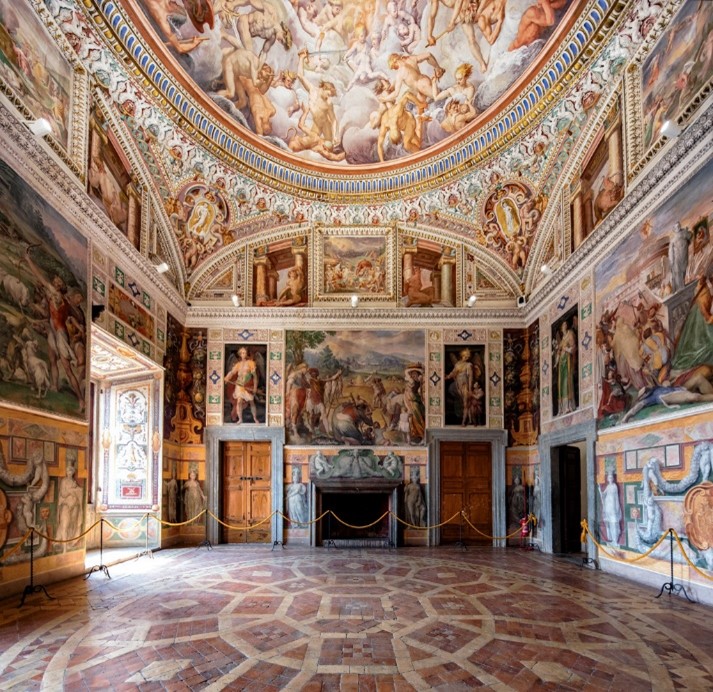
DAY 2 VITERBO
In Viterbo you’ll travel back in time, walking in the halls of the elegant Papal Palace and along intact medieval alleys, and admiring monumental fountains and Renaissance patrician palaces.
The Papal Palace, with its beautiful columned loggia with pointed arches, was built from 1257 onwards to provide the Pontiff with a safer seat than Rome, at the time the scene of bitter disputes: here is what has become famous as “Sala del Conclave” (from the Latin “cum clave”, under lock and key) where the cardinals, divided over the name of the new Pontiff, were segregated until an agreement was reached. It took 33 months for Gregory X to be elected and since then the term “conclave” has been used to refer to the meeting of cardinals called to elect a new pope. The Papal Palace is located in the elegant Piazza San Lorenzo, overlooked by the 12th-century Cathedral.
In the evocative San Pellegrino District, you’ll walk see the characteristic “bridge” houses, connected at first or second floor level, between which there are evocative covered passageways, most being accessed by stairways, locally called “profferli”: the most beautiful one is the Alessandri house, with its internal staircase flanked by a parapet. The neighbourhood is also home to the Museum of the Sodalizio dei Facchini di Santa Rosa, celebrating the city's most heartfelt and deep-rooted festival: on September 3rd, porters from the various quarters of the city carry in procession the very heavy (5100 kg!) “Macchina di Santa Rosa”, a sort of 30-metre high tower. The festival celebrates Santa Rosa, whose incorrupt relics have been venerated since the 13th century. Infact, several years after her death, Santa Rosa’s body was found to be incorrupt at the site of her burial. Her body had not decayed, a sign of her sanctity.
Viterbo is a city of water: “Fontana Grande” (The Great Fountain), in the so-called square, is just one of the many monumental fountains that spring from every square in the historic centre. Just a few more steps and you end up in the square of the Palazzo dei Priori, which once was the symbol of the city's power, with large frescoed rooms, such as the Palatine Chapel painted by Filippo Cavarozzi and Marzio Ganassini.
Viterbo offers a peasant cuisine that draws on the products of its generous land: in winter, you can try a hearty chestnut and chickpea soup or the lighter acquacotta, a “minestrone” (vegetables soup) enriched with eggs and bread croutons. During the feast of Santa Rosa, you cannot miss pignattaccia, a dish made of tripe and other poor cuts of meat with potatoes, flavoured with herbs and slowly baked.
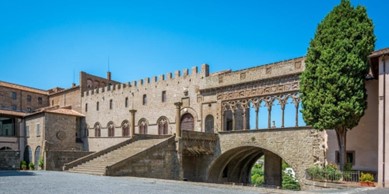
DAY 3 ORVIETO & CIVITA DI BAGNOREGIO
Orvieto in Umbria is perhaps the most beautiful hill town in Italy, perched up on a volcanic rock, its history dating back to the Etruscans.
Although just an hour from Rome, the architecture is different, with many of the buildings constructed out of “tufo”, a volcanic rock. Orvieto’s main attraction is its 14th-century Cathedral – a masterpiece of Gothic architecture with a glistening façade of stained glass, mosaics and sculptures. Another attraction is St. Patrick’s Well, a 62-meter-deep (203 feet) feat of engineering characterized by two spiral staircases that wind around the well (yet never meet), with 248 steps down to the water. A pleasant guided tour along a straightforward route makes it possible to know Orvieto’s underground world, created by its ancient inhabitants over about 2,500 years of uninterrupted digging. A tour at the discovery of a millenary, surprising and unexpected “Underground City”, you will surely enjoy it!
At lunch, don’t miss “salumi di cinghiale o cervo” (boar or deer sausage) and pecorino cheese and taste the region's prized white truffle oil together with the delicious white wine of the area, Orvieto Classico!
Civita di Bagnoregio, the spectacular “borgo” slowly sliding towards the valley, is also known as the “Dying City”. The town is famous for its unique position atop a plateau of friable volcanic tuff overlooking the Tiber valley. It is in constant danger of destruction as the edges of the plateau collapse due to erosion, leaving the buildings to crumble as their underlying support falls away.
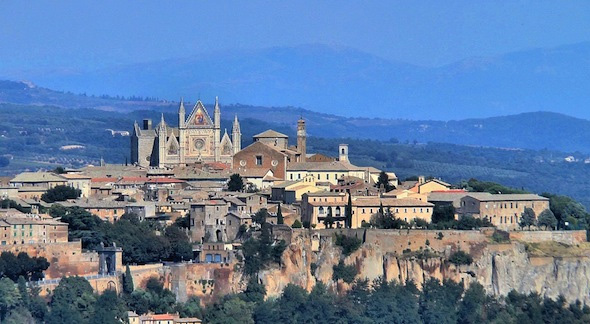
DAY 4 PERUGIA & ASSISI
Perugia lies on a hill 500 m. above sea level, with the old town spreading all around it and partly surrounded by Etruscan and Medieval Walls. Unfortunately, only a few ancient city remains have survived; the remaining urban centre is mainly medieval in style. The old town is, in fact, a typical Medieval village, one of the most beautiful in Italy.
A sightseeing tour includes Piazza Matteotti, also known as Sopramuro (“above the walls”), with Palazzo dell'Università Vecchia and Palazzo del Capitano del Popolo. Beside it, we will admire one of the most beautiful squares of Italy: Piazza IV Novembre, which can be considered the monumental and social core of the city, with at its centre Fontana Maggiore, a sculptural masterpiece by Giovanni and Nicola Pisano. This architectonical complex includes Palazzo dei Priori, built between the 13th and 14th Centuries, a symbol of the civil power of the time and now the home of the National Gallery of Umbria, which hosts the most important collection of Umbrian paintings, including several pieces by Perugino.
Assisi is the birthplace of Francis, the nobleman who renounced all his possessions to devote his life to helping the needy and became the most acclaimed Saint of the Catholic Church.
The splendid Basilica, one of the emblems of Christianity, located on Mount Subasio and overlooking the entire valley, is dedicated to him. Apart from being a strong appeal to millions of religious believers, the Basilica is a monument of great artistic value. The construction of the Basilica began two years after his death, in 1228, and between the end of the 13th and the beginning of the 14th century, the basilica's walls were frescoed by the best artists of that time: Giotto, Cimabue, Simone Martini and Pietro Lorenzetti. St. Francis' Basilica consists of two churches laid upon each other and a crypt containing the tomb of the Saint. The Lower Basilica presents a simple facade with a double front portal embellished with a rose window and a mosaic. The interior is decorated with frescoes by some of the most important painters from 1200 to 1300, from Cimabue to Giotto, from the Lorenzettis to Simone Martini.
In the Upper Basilica, you will admire the frescoes of the life of St. Francis, painted by Giotto, the stories of the Old and New Testament covering the entire nave, and other beautiful frescoes by Cimabue and Torriti.
Another figure who profoundly influenced these places is Saint Clare, to whom the homonymous Basilica -with a facade made of white and pink stone and divided into three sections by horizontal cornices - is dedicated. The interior frescoes and the remains of the Saint are visible through a window in the crypt.
Try to enjoy the mystical atmosphere of Assisi:
"Be praised, my Lord, through our sister Mother Earth,
Who feeds us and rules us,
And produces various fruits with coloured flowers and herbs."
(St. Francis, Prayer of the Canticle of the Creatures)

DAY 6 URBINO & SAN MARINO
Between the Metauro Valley and the Foglia Valley, in the hills of the Marche region facing the Adriatic Sea, lies the city of Urbino, one of the most important centres of the Italian Renaissance, whose artistic charm and architectural heritage are still preserved today.
Embellished with sandstone buildings and surrounded by a long wall of brickwork, Urbino is a city of vast historical and artistic wealth. From a simple village, under Duke Federico di Montefeltro, it became the “cradle of the Renaissance” and, even today, walking through its historical centre you can breathe in the 15th-century air.
In 1998, Urbino was honourably included in the UNESCO World Heritage List for being a point of attraction for the most illustrious Renaissance scholars and artists from all over Italy and the world, and for having influenced cultural progress in the rest of Europe, while managing to keep its exceptional urban complex almost intact. Urbino is also Raffaello’s birthplace, one of the greatest painters of the Renaissance, and home to one of the oldest, most important universities in Europe, founded in 1506.
Palazzo Ducale (The Duke’s Palace) is one of the most interesting architectural and artistic examples of the entire Italian Renaissance. Baldassarre Castiglione called it a 'Palace in the shape of a city', impressed as he was by the palace where Federico da Montefeltro lived. With its characteristic small towers, the palace is home to the Galleria Nazionale delle Marche: the splendid architectural setting of the interior created by Laurana houses one of the most beautiful and important art collections of the Italian Renaissance. Duke Federico's studio inside the palace has a valuable coffered ceiling with the lower band covered with inlaid wood by Baccio Pontelli, per the designs of Sandro Botticelli, Francesco di Giorgio Martini and Donato Bramante.
The local specialities include the renowned 'Casciotta d'Urbino', a recognised PDO product; the semi-hard cheese has been made since ancient times. 'Crescia urbinate', also known as 'crescia sfogliata' is also quite tasty: a sort of focaccia eaten hot with sausage, field greens, ham, loin or cheese.
In the heart of Italy, on the border between Emilia Romagna and Marche, the Republic of San Marino is a small independent state, the third smallest country in Europe, behind the Principality of Monaco and the Vatican City. Entrance is free and there is no charge to enter. The currency is the Euro, so it is very convenient for shopping.
Monte Titano with its three “feathers” represents the symbol of the country. It marks the beginnings of the Tuscan-Romagna Apennines and, at 755 meters above sea level, is the highest point in the country. In fact, the mountain has an unusual configuration for the surrounding area, which is predominantly hilly. It is, in fact, a limestone-arenaceous rock, a remnant of the shattering of a large submarine plate twenty million years ago. The territory is organized into Castelli (municipalities), with the Capital City of San Marino holding the most interesting places to visit.
The medieval town is among the best-preserved in Europe and reserves many surprises for tourists, which is why it was also recognized as a UNESCO World Heritage Site in 2008. In the historic centre, located on top of Mount Titan and surrounded by the ancient walls, you can take a walk joining the Three Towers. Start from the First Tower, also called Guaita: dating back to the year 1000, it also features the ancient prisons, the Bell Tower and Penna Tower, a well and the Chapel of St. Barbara. Climbing to the highest point of the Tower, you can admire the whole surrounding area, all the way to the coast.
Then, walk to the Second Tower (watch out for the “Witches’ Pass“!). Also named Cesta, it was used until the 1600s as a fortified watchtower; today, its interior houses the Museum of Ancient Weapons. Finally you’ll come to the Third Tower, Montale. You climb up some iron steps and can admire the exterior, but the interior cannot be visited.
Back in the streets of the historic centre, you will stop in Piazza della Libertà (Freedom Square): in the centre stands the Statue of Liberty, the symbol of the long tradition of freedom of San Marino’s state identity. From its “belvedere,” you will enjoy the splendid view of the countryside and the Riviera! In Piazza della Libertà, you may also visit Palazzo Pubblico, seat of the San Marino government, and, not far away, Basilica del Santo.
The streets of the medieval village are full of small stores selling souvenirs, typical products and local handicrafts, with little gems of local gastronomy not to be missed. Thanks in part to a lower tax burden than in Italy, you may find excellent prices for jewellery, perfumes, liquor and weapons, including reproductions of traditional crossbows.
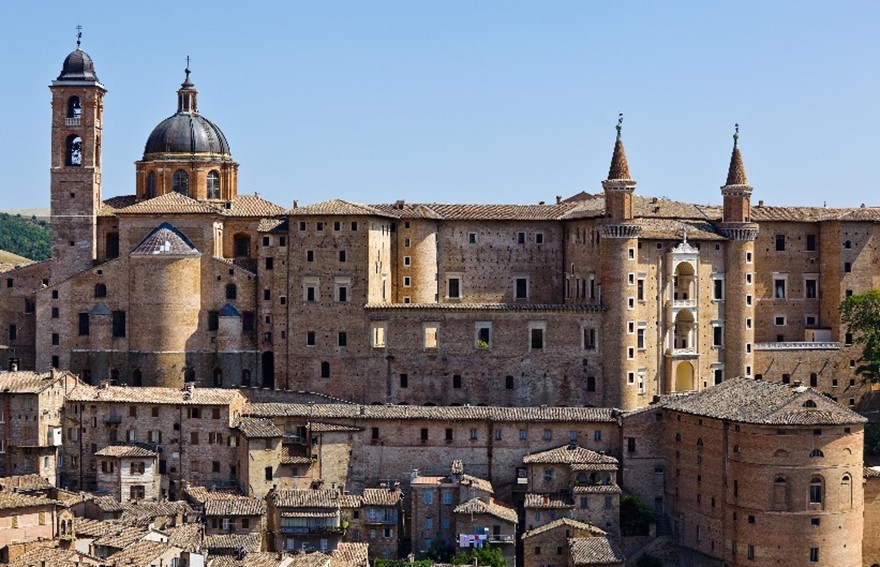
DAY 7 GENGA & FABRIANO
In Genga, inside the Red Gorge Regional Park, inside a large cave, lies a hidden jewel worth the visit: the small Valadier Temple.
The Valadier Temple is an octagonal sanctuary in neoclassical style built in 1828 by Pope Leo XII and designed by the famous architect Giuseppe Valadier.
Nestled between the rocky walls of the mountain, the temple has an octagonal base and is entirely built with blocks of white travertine extracted from a quarry above the cave in which it stands, in contrast to the dome covered with lead. On the facades, there are three orders of windows and two entrances to the temple, finally, the statue of the Virgin with Child in white Carrara marble by Antonio Canova, placed on the altar inside, is even more precious because it is inserted in such an impervious context.
Do you know how paper was made in the Middle Ages? Fabriano was the most important centre for the production of handmade paper until paper was industrialised. Here, we will assist in a live demonstration of hand-made paper, performed by the Museum's Master paper makers, viewing the antique watermarks from the 13th century to modern day.
You won’t leave Fabriano before tasting its excellent salame, a Slow Food Italian Presidium, with a glass of Torgiano red wine!
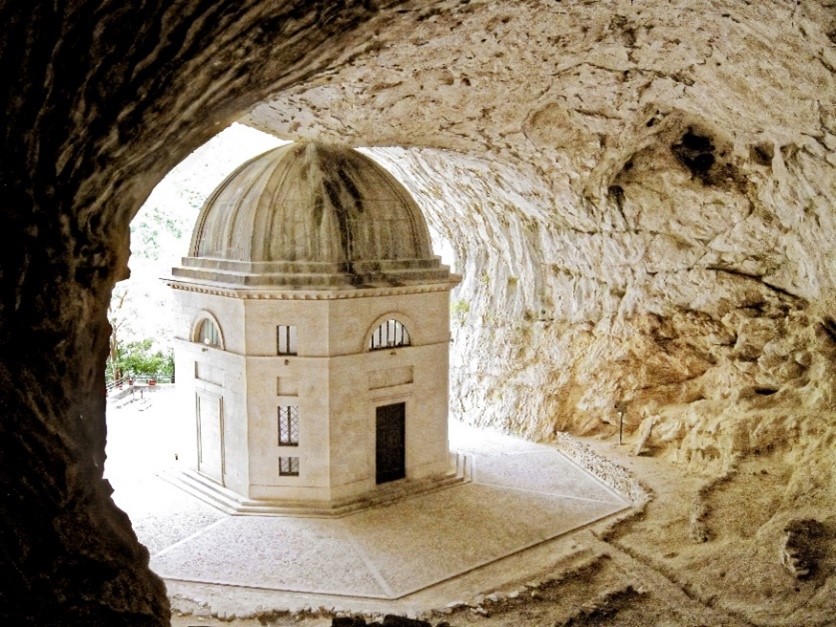
DAT 8 ASCOLI PICENO
Ascoli Piceno is a city where history, art, food and wine all coexist, expressing all the beauty that Italy can be. Due to the small size of its historic centre with the ancient travertine buildings, the stately, elegant squares, the historic churches rich in treasures, the towers and bell towers, the city still retains the incomparable charm of the villages of central Italy, where time seems to have stood still. The culture and popular appeal of Ascoli Piceno will surely steal your heart.
The history of Ascoli Piceno is steeped in ancient origins. Although findings indicate that the area was already inhabited in the Neolithic era, it was in the 3rd century BC that the Romans settled in the Picenian territory, thus making Asculum a key centre, also thanks to its position on the Via Salaria. The Roman period was synonymous with great prosperity for Ascoli Piceno and the whole of the Marche region. In the Middle Ages and during the Renaissance, Ascoli Piceno was dominated by various seigniories, the Malatesta and Sforza to name but a few, and was in the possession of the Papal State until it joined the Kingdom of Italy in 1870.
Palazzo dei Capitani with its medieval crenellated tower is an architectural symbol of the entire city. Be sure to make a stop at the historic Cafe Meletti, which has always been considered the meeting place of the most illustrious personalities, as well as a venue for culture and social life. But it doesn't end here; you should not miss the Roman bridge, Forte Malatesta, the Cathedral of San Emidio, the church of San Francesco and the Papal Paper mill.
Ascoli Piceno also offers great gastronomic delights, satisfying even the most demanding palates. At the top of the list are the famous stuffed olives, known as “olive all’ascolana”, exclusively made with olives from the area. Also, you should not miss vincisgrassi, a baked pasta made up of several layers, topped with grated Parmesan cheese and a special ragout made with different types of meat for which each family has a special recipe. For the lovers of leavened products, the cheese pizza and the cacciannanze ascolana, a special focaccia with oil and rosemary, will captivate you. Moving on to desserts, the Carnival ravioli eaten in this town are second to none. And for the bonus, why not end on a high note with an anisette, a typical liqueur made from green aniseed.perhaps with a roasted coffee bean. It's practically a moral obligation.
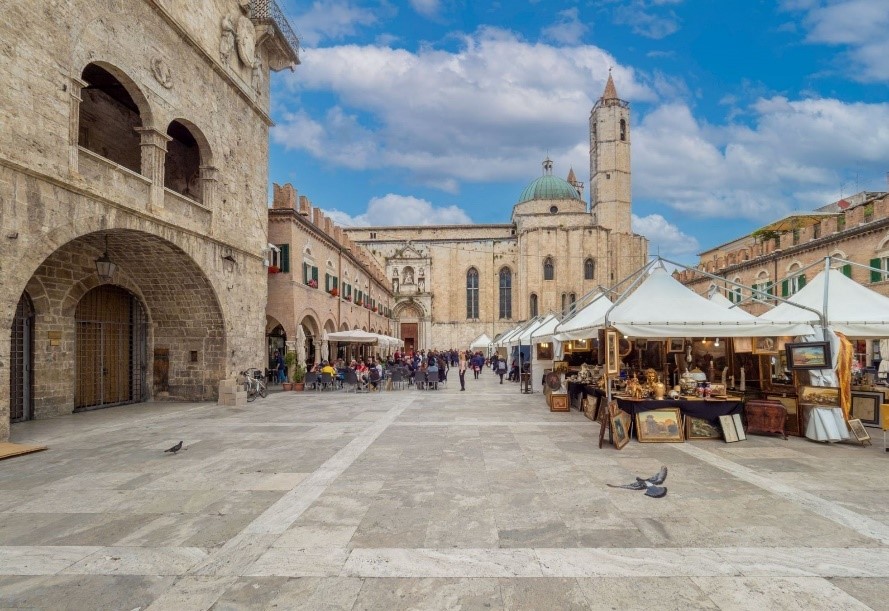
DAYS 9 & 10 UMBRIA
Umbria is the greenest region of Italy, and its citizens are famous for their hospitality. This morning, our first stop will be Spoleto, a medieval hill town in the Umbria region, famous for its summer music festival, “Festival dei Due Mondi”. Thick walls and a magnificent gorge surround the city, and fine medieval and Roman monuments sit along the streets. The Duomo is one of Spoleto's most pleasing sights: dating back to the 12th century, the cathedral is set against a backdrop of hills and valleys. The Rocca is high above the town, a Papal fortress used as a prison until the 1980s. A massive bridge, Ponte delle Torri, built in the 14th century, functioned as a bridge and aqueduct; we can walk on it for breathtaking views of the valley and gorge below.
In Spoleto, you can try a typical Spoletan food, “torta al testo” (bread prepared with water, flour, salt, pepper, and olive oil and cooked on a particular marble stone in a wood-burning oven); it is sometimes stuffed with ham, sausage, or simply with herbs prepared in olive oil.
Then, you’ll head for Deruta, famous for its splendid, brightly coloured maiolica. The production of ceramics in Deruta goes back to the 13th century. In those times, small “bottegas” produced objects of everyday use: jugs, bowls, and basins. Maiolica reached its apex in the 16th century, with artists making various motifs, such as mythological figures, battles and religious scenes.
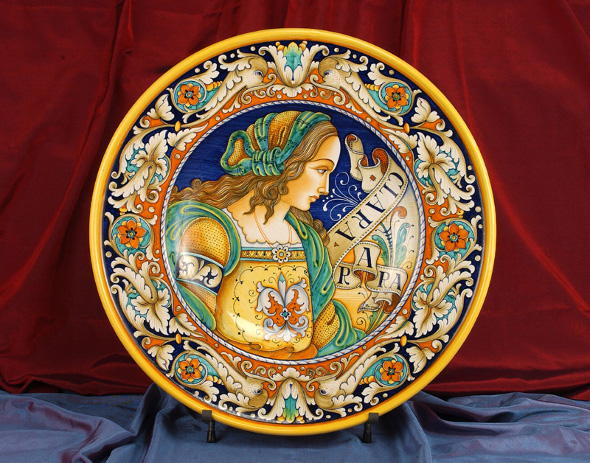
DAY 11 TIVOLI
Discover one of Italy's hidden gems! Here is Tivoli, a small town about 30 Km east of Rome, boasting 2 of the most spectacular sites in Italy, Emperor Hadrian's Villa and Villa d'Este.
Emperor Hadrian built his villa to escape the crowd and turmoil of the capital. Much of the enormous, luxurious ancient villa remains intact today. You will be surprised by the innovative application of Renaissance plumbing in the fountains and waterworks, perfectly integrated with the landscape.
The other masterpiece in the area is Villa d’Este, the fantastic Villa commissioned by Cardinal Ippolito of the Este family around 1560. Among the masterpieces of the Italian Renaissance that most inspired landscape architects and painters, it is an ideal reinterpretation - in a sumptuous way - of the hanging Eden of Babylon. The prestigious residence is surrounded by terraces, stairways and avenues set on each other, decorated with water games so audacious as to reveal considerable engineering skills. The monument was elected the most beautiful park in Europe and UNESCO Heritage with the motivation: "one of the first gardens of wonders, which from the beginning had a decisive influence on the development of European landscape painting ».
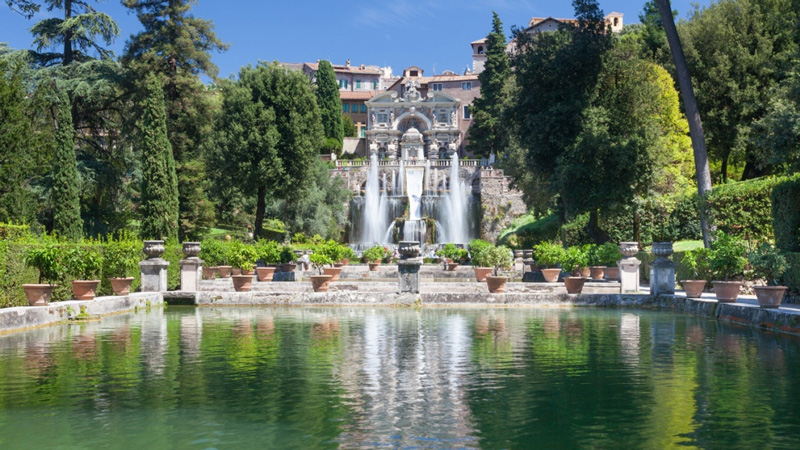
The tour is over, but the memories of a fantastic journey will accompany you for a lifetime!
Arrivederci for another tour with VITOR, Visit Italy on the Road.
